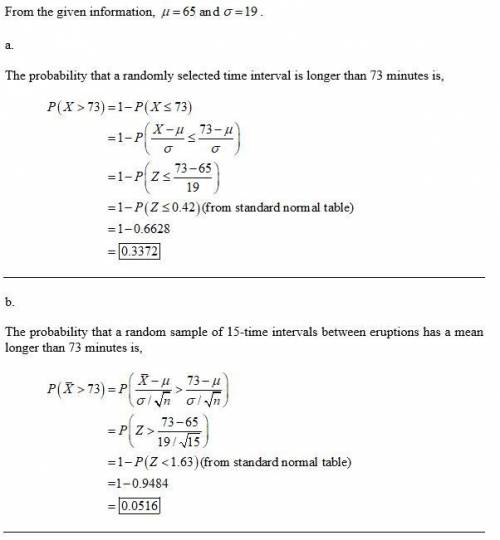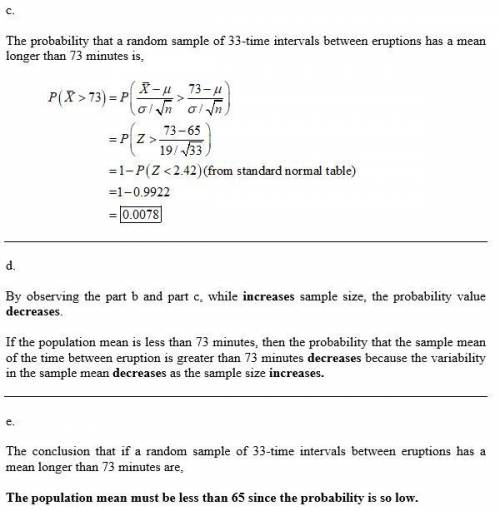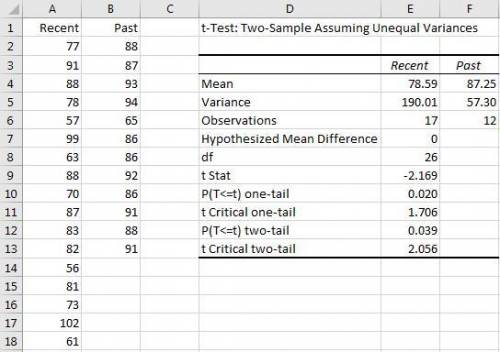 The probability that a random sample of 13 time intervals between eruptions has a mean longer than 82 minutes =
The probability that a random sample of 13 time intervals between eruptions has a mean longer than 82 minutes =  The probability that a random sample of 34 time intervals between eruptions has a mean longer than 82 minutes =
The probability that a random sample of 34 time intervals between eruptions has a mean longer than 82 minutes = 
Step-by-step explanation:
From the given data
mean, u = 72
Standard deviation  = 23
= 23
A) Probability that a randomly selected time interval between eruptions is longer than 82minutes
![P (x 82) = P[\frac{x-u}{\rho} \frac{82-72}{23}]\\\\P (x 82) = P[z 0.43]\\\\P (x 82) = 0.3336](/tpl/images/0715/1926/da3cc.png)
B)
![P (x 82) = P[\frac{x-u}{\frac{\rho}{\sqrtn}} \frac{82-72}{\frac{23}{\sqrt{13}}}]\\\\P (x 82) = P[z 1.5676]\\\\P (x 82) = 0.0594](/tpl/images/0715/1926/1bc99.png)
C)
![P (x 82) = P[\frac{x-u}{\frac{\rho}{\sqrtn}} \frac{82-72}{\frac{23}{\sqrt{34}}}]\\\\P (x 82) = P[z 2.5351]\\\\P (x 82) = 0.0057\\\\](/tpl/images/0715/1926/59de0.png)
D) If the mean is less than 82minutes, then the probability that the sample mean of the time between eruptions is greater than 83 minutes decrease because the variability in the sample mean decrease as the sample size increases
For more information on this visit
link
 The probability that a random sample of 13 time intervals between eruptions has a mean longer than 82 minutes =
The probability that a random sample of 13 time intervals between eruptions has a mean longer than 82 minutes =  The probability that a random sample of 34 time intervals between eruptions has a mean longer than 82 minutes =
The probability that a random sample of 34 time intervals between eruptions has a mean longer than 82 minutes = 
Step-by-step explanation:
From the given data
mean, u = 72
Standard deviation  = 23
= 23
A) Probability that a randomly selected time interval between eruptions is longer than 82minutes
![P (x 82) = P[\frac{x-u}{\rho} \frac{82-72}{23}]\\\\P (x 82) = P[z 0.43]\\\\P (x 82) = 0.3336](/tpl/images/0715/1926/da3cc.png)
B)
![P (x 82) = P[\frac{x-u}{\frac{\rho}{\sqrtn}} \frac{82-72}{\frac{23}{\sqrt{13}}}]\\\\P (x 82) = P[z 1.5676]\\\\P (x 82) = 0.0594](/tpl/images/0715/1926/1bc99.png)
C)
![P (x 82) = P[\frac{x-u}{\frac{\rho}{\sqrtn}} \frac{82-72}{\frac{23}{\sqrt{34}}}]\\\\P (x 82) = P[z 2.5351]\\\\P (x 82) = 0.0057\\\\](/tpl/images/0715/1926/59de0.png)
D) If the mean is less than 82minutes, then the probability that the sample mean of the time between eruptions is greater than 83 minutes decrease because the variability in the sample mean decrease as the sample size increases
For more information on this visit
link
The answer is provided in the attachment


The answer is provided in the attachment


(a) The probability that a randomly selected Time interval between irruption is longer than 84 minutes is 0.3264.
(b) The probability that a random sample of 13 time intervals between irruption has a mean longer than 84 minutes is 0.0526.
(c) The probability that a random sample of 20 time intervals between irruption has a mean longer than 84 minutes is 0.0222.
(d) The probability decreases because the variability in the sample mean decreases as we increase the sample size
(e) The population mean may be larger than 75 minutes between irruption.
Step-by-step explanation:
We are given that a geyser has a mean time between irruption of 75 minutes. Also, the interval of time between the eruption is normally distributed with a standard deviation of 20 minutes.
(a) Let X = the interval of time between the eruption
So, X ~ Normal( )
)
The z-score probability distribution for the normal distribution is given by;
Z =  ~ N(0,1)
~ N(0,1)
where,  = population mean time between irruption = 75 minutes
= population mean time between irruption = 75 minutes
 = standard deviation = 20 minutes
= standard deviation = 20 minutes
Now, the probability that a randomly selected Time interval between irruption is longer than 84 minutes is given by = P(X > 84 min)
P(X > 84 min) = P(  >
>  ) = P(Z > 0.45) = 1 - P(Z
) = P(Z > 0.45) = 1 - P(Z  0.45)
0.45)
= 1 - 0.6736 = 0.3264
The above probability is calculated by looking at the value of x = 0.45 in the z table which has an area of 0.6736.
(b) Let  = sample time intervals between the eruption
= sample time intervals between the eruption
The z-score probability distribution for the sample mean is given by;
Z =  ~ N(0,1)
~ N(0,1)
where,  = population mean time between irruption = 75 minutes
= population mean time between irruption = 75 minutes
 = standard deviation = 20 minutes
= standard deviation = 20 minutes
n = sample of time intervals = 13
Now, the probability that a random sample of 13 time intervals between irruption has a mean longer than 84 minutes is given by = P( > 84 min)
> 84 min)
P( > 84 min) = P(
> 84 min) = P(  >
>  ) = P(Z > 1.62) = 1 - P(Z
) = P(Z > 1.62) = 1 - P(Z  1.62)
1.62)
= 1 - 0.9474 = 0.0526
The above probability is calculated by looking at the value of x = 1.62 in the z table which has an area of 0.9474.
(c) Let  = sample time intervals between the eruption
= sample time intervals between the eruption
The z-score probability distribution for the sample mean is given by;
Z =  ~ N(0,1)
~ N(0,1)
where,  = population mean time between irruption = 75 minutes
= population mean time between irruption = 75 minutes
 = standard deviation = 20 minutes
= standard deviation = 20 minutes
n = sample of time intervals = 20
Now, the probability that a random sample of 20 time intervals between irruption has a mean longer than 84 minutes is given by = P( > 84 min)
> 84 min)
P( > 84 min) = P(
> 84 min) = P(  >
>  ) = P(Z > 2.01) = 1 - P(Z
) = P(Z > 2.01) = 1 - P(Z  2.01)
2.01)
= 1 - 0.9778 = 0.0222
The above probability is calculated by looking at the value of x = 2.01 in the z table which has an area of 0.9778.
(d) When increasing the sample size, the probability decreases because the variability in the sample mean decreases as we increase the sample size which we can clearly see in part (b) and (c) of the question.
(e) Since it is clear that the probability that a random sample of 20 time intervals between irruption has a mean longer than 84 minutes is very slow(less than 5%0 which means that this is an unusual event. So, we can conclude that the population mean may be larger than 75 minutes between irruption.
(a) The probability that a randomly selected Time interval between irruption is longer than 84 minutes is 0.3264.
(b) The probability that a random sample of 13 time intervals between irruption has a mean longer than 84 minutes is 0.0526.
(c) The probability that a random sample of 20 time intervals between irruption has a mean longer than 84 minutes is 0.0222.
(d) The probability decreases because the variability in the sample mean decreases as we increase the sample size
(e) The population mean may be larger than 75 minutes between irruption.
Step-by-step explanation:
We are given that a geyser has a mean time between irruption of 75 minutes. Also, the interval of time between the eruption is normally distributed with a standard deviation of 20 minutes.
(a) Let X = the interval of time between the eruption
So, X ~ Normal( )
)
The z-score probability distribution for the normal distribution is given by;
Z =  ~ N(0,1)
~ N(0,1)
where,  = population mean time between irruption = 75 minutes
= population mean time between irruption = 75 minutes
 = standard deviation = 20 minutes
= standard deviation = 20 minutes
Now, the probability that a randomly selected Time interval between irruption is longer than 84 minutes is given by = P(X > 84 min)
P(X > 84 min) = P(  >
>  ) = P(Z > 0.45) = 1 - P(Z
) = P(Z > 0.45) = 1 - P(Z  0.45)
0.45)
= 1 - 0.6736 = 0.3264
The above probability is calculated by looking at the value of x = 0.45 in the z table which has an area of 0.6736.
(b) Let  = sample time intervals between the eruption
= sample time intervals between the eruption
The z-score probability distribution for the sample mean is given by;
Z =  ~ N(0,1)
~ N(0,1)
where,  = population mean time between irruption = 75 minutes
= population mean time between irruption = 75 minutes
 = standard deviation = 20 minutes
= standard deviation = 20 minutes
n = sample of time intervals = 13
Now, the probability that a random sample of 13 time intervals between irruption has a mean longer than 84 minutes is given by = P( > 84 min)
> 84 min)
P( > 84 min) = P(
> 84 min) = P(  >
>  ) = P(Z > 1.62) = 1 - P(Z
) = P(Z > 1.62) = 1 - P(Z  1.62)
1.62)
= 1 - 0.9474 = 0.0526
The above probability is calculated by looking at the value of x = 1.62 in the z table which has an area of 0.9474.
(c) Let  = sample time intervals between the eruption
= sample time intervals between the eruption
The z-score probability distribution for the sample mean is given by;
Z =  ~ N(0,1)
~ N(0,1)
where,  = population mean time between irruption = 75 minutes
= population mean time between irruption = 75 minutes
 = standard deviation = 20 minutes
= standard deviation = 20 minutes
n = sample of time intervals = 20
Now, the probability that a random sample of 20 time intervals between irruption has a mean longer than 84 minutes is given by = P( > 84 min)
> 84 min)
P( > 84 min) = P(
> 84 min) = P(  >
>  ) = P(Z > 2.01) = 1 - P(Z
) = P(Z > 2.01) = 1 - P(Z  2.01)
2.01)
= 1 - 0.9778 = 0.0222
The above probability is calculated by looking at the value of x = 2.01 in the z table which has an area of 0.9778.
(d) When increasing the sample size, the probability decreases because the variability in the sample mean decreases as we increase the sample size which we can clearly see in part (b) and (c) of the question.
(e) Since it is clear that the probability that a random sample of 20 time intervals between irruption has a mean longer than 84 minutes is very slow(less than 5%0 which means that this is an unusual event. So, we can conclude that the population mean may be larger than 75 minutes between irruption.
 1
1 The correct answer is We can predict the time between eruptions will be 10.73 minutes and this can be stated with 0.901 probability.
Eruptions do not always produce symmetrical and imposing cones. Volcanic relief has varied shapes and we must analyze the properties of the lava and the conditions of spill occurrence to understand.
 1
1 The correct answer is We can predict the time between eruptions will be 10.73 minutes and this can be stated with 0.901 probability.
Eruptions do not always produce symmetrical and imposing cones. Volcanic relief has varied shapes and we must analyze the properties of the lava and the conditions of spill occurrence to understand.
p value = 0.039
t = - 2.169
Step-by-step explanation:
Applying the null and alternate hypothesis


using excel worksheet to calculate for ( t and p )
t = -2.169
p = 0.039
from the results obtained
The conclusion is affected by the significance level because : 0.1 < p > 0.01
so when the significance level is = 0.1 the Null hypothesis is rejected and we can say the mean time interval will change while
if the significance level = 0.01 the Null hypothesis is accepted and we can not say the mean time interval has changed because the p -value is greater than 0.01
attached is the excel solution

SI=(P*R*T)/100
P=2000
R=1.5
T=6
SI=(2000*1.5*6)/100
=(2000*9)/100
=180
Neil will earn interest of 180

It will provide an instant answer!
